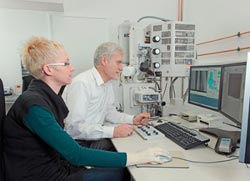Recycling Carbon Fibers from Composite Materials

<br>
These lightweight materials consist of two main components with, for example, woven carbon fibers and a polymer matrix material. Current application areas for such composites include aircraft manufacturing.
However, the materials are also increasingly being used in the automotive industry due to their high stability and because they have a lower density than aluminum. Carbon fibers are relatively expensive because the process used to manufacture them is costly and requires a lot of energy.
The recycling of carbon fibers therefore has to be carried out as efficiently as possible. As reported in the latest edition of the “Pictures of the Future” research magazine, the Siemens approach here involves recovering the fibers in the same form they were used and without any loss of mass.
This ensures they will retain their properties to the greatest extent possible. Siemens developed the associated process in the MAI Carbon research cluster.
The goal of MAIrecycling – the lead project in the cluster – is to establish a complete recycling process chain for production rejects, complex mixed materials, and reprocessed carbon fibers that are suitable for reuse in various products. The project partners include Audi, BMW, SGL Carbon, Neenah-Gessner, Voith Composites, the Fraunhofer Institute for Building Physics, and the bifa environmental institute.
These days, carbon fibers are usually extracted from used components or production scrap by breaking down resins in a pyrolytic process at relatively high temperatures. In the solvolysis recycling procedure employed by scientists at Siemens Corporate Technology, the resin component is heated under pressure at a temperature of 200 degrees Celsius and converted to low molecular-weight soluble alcohols with the help of water. No environmentally damaging solvents are used in the process, which also requires much less energy than would be required to manufacture new fibers.
The woven fabric recovered from the workpiece retains its shape and its fibers remain intact. As a result, it can be immediately further processed. The fibers' mechanical properties are also nearly fully retained. As a next step, the researchers are now looking for ways to use the recycled fibers in new types of reshaped workpieces.
Media Contact
More Information:
http://www.siemens.com/innovationnewsAll latest news from the category: Process Engineering
This special field revolves around processes for modifying material properties (milling, cooling), composition (filtration, distillation) and type (oxidation, hydration).
Valuable information is available on a broad range of technologies including material separation, laser processes, measuring techniques and robot engineering in addition to testing methods and coating and materials analysis processes.
Newest articles

A universal framework for spatial biology
SpatialData is a freely accessible tool to unify and integrate data from different omics technologies accounting for spatial information, which can provide holistic insights into health and disease. Biological processes…

How complex biological processes arise
A $20 million grant from the U.S. National Science Foundation (NSF) will support the establishment and operation of the National Synthesis Center for Emergence in the Molecular and Cellular Sciences (NCEMS) at…

Airborne single-photon lidar system achieves high-resolution 3D imaging
Compact, low-power system opens doors for photon-efficient drone and satellite-based environmental monitoring and mapping. Researchers have developed a compact and lightweight single-photon airborne lidar system that can acquire high-resolution 3D…





















